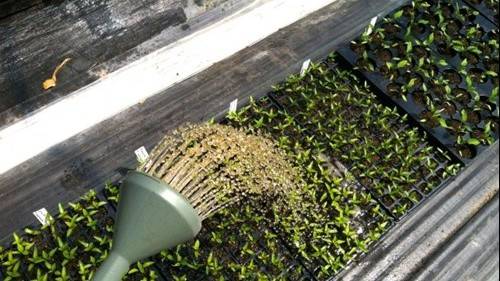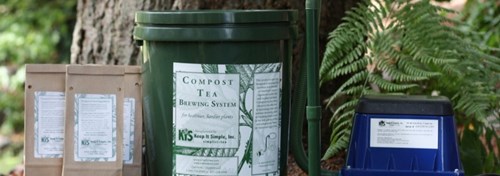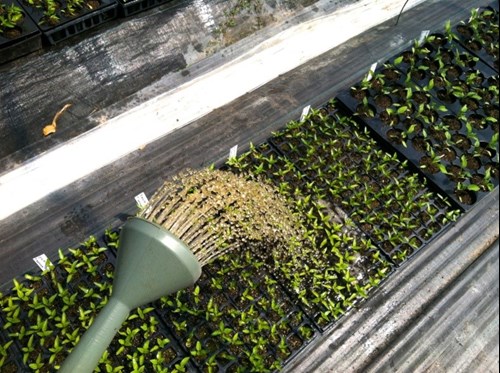Compost Tea Use with Soilless Media


Compost tea is not a new concept in agriculture or horticulture. Compost tea is stabilized organic matter (compost) and water mixed together. The beneficial claims that are made regarding compost tea are very similar to those for compost with the advantage of being able to spray it on crops or drench soil or growing media. It can provide plant growth compounds and beneficial microorganisms to enhance plant growth and help in preventing diseases. In the past 10 years or so, it has been promoted mainly for enhancing microbial activity in soils. A lot of organic growers became interested in making compost tea because few products were available for disease suppression.
Alleged claims that compost tea can control diseases generated a lot of criticism from scientists; they found conflicting results regarding the suppression of diseases, such as gray mold (Scheuerell & Mahaffee 2006). More recently, with the growing interest in both conventional and organic agriculture to develop practices that positively impact crop productivity, many university researchers have investigated the different practices in making compost tea. They have identified some key methods for making compost tea and more consistent results have been published in scientific publications (Scheuerell & Mahaffee 2006). More research is still required to understand the mode of action of the microbes in compost tea and clarify the by-products produced by them.
What Is Compost Tea?
Compost tea is produced by mixing compost with water and brewing it for a defined period; usually 24-48 hours. A large container or rainwater barrel can be used to make the tea which then can either be aerated or not. Aeration supplies oxygen uniformly through the tea which favors the development of microorganisms that need oxygen to live (like most microorganisms found in arable soils).
Many other additives can be added to the tea to improve efficacy like kelp extract, rock dust and humic acid.


Application
Ideally, compost tea should be used rapidly, within 4-6 hours after it’s made. Shelf life can be extended by keeping it cool and periodically stirring it. Eventually, however, the microorganisms in the tea will consume all the food available to them, causing their populations to rapidly decline.
Compost tea should be applied directly to the growing medium or the foliage. For soil drenching, it can be applied at either full strength or diluted 1:1 (water: compost tea) to provide enough solution to thoroughly saturate the root zone. If applied to the foliage, do so early in the morning to avoid sun and UV degradation of the tea.

Understanding How It Can Help Crops
You might wonder how these introduced microbes coming from the compost tea can suppress unwanted diseases or improve plant growth. The literature shows results of the beneficial effects, but explanations are complex and depend on many factors, including plant species, compost quality, extraction method and growing conditions.
Below are some results reported in the literature (Scheuerell & Mahaffee 2006):
- The overall soil biological activity is increased with the use of compost tea.
- Documented growth benefits could be from the substances produced in the compost teas during the brewing process or by-products produced by the microorganisms.
- As with compost, compost tea comes with high levels of microorganisms that occupy the root zone and compete with undesirable microorganisms.
Compost Tea Use With Soilless Media
Compost teas work well with most soilless media and can serve as a preventive measure to suppress pathogens before they cause disease. It would be important however to verify that these microorganisms are compatible with any beneficial organisms that are pre-mixed into growing media used to control root disease pathogens. Compost tea is not considered a fertilizer (as it provides minimal nutrient levels) nor is it considered a fungicide or pesticide either. It enhances microbial activity in the growing medium which helps improve plant growth.
Microorganisms Present in Compost Teas
Compost tea contains mainly bacteria and fungi. Total counts of bacteria from the compost tea average about 7 x 1010 active cells per milliliter. In growing media, these numbers will be lower because of dilution with the growing media and subsequent watering.
Mycorrhizal fungi, like those found in PRO-MIX® products, are not provided by compost tea. To provide them, use PRO-MIX® products with AGTIV® REACH™ or apply AGTIV® REACH™ inoculants. Mycorrhizal fungi are compatible with the microorganisms found in compost tea. In fact, they work with mycorrhizal fungi to provide plants with additional benefits.
Mycorrhizae cannot be added to compost tea because they do not survive with its high population of microorganisms for more than a couple of hours. In growing media, it is different because the concentration of microorganisms is much lower than in the highly concentrated compost tea. Mycorrhizal spores do have a certain resistance to heat, cold and drought because they are storage organs. However, this resistance is acquired progressively in soils, but not when put in an actively brewing solution.
Conclusion
Testing is a key aspect when using compost teas. Keep in mind that the use and brewing of the compost tea may need to be adapted to the growing conditions and environment in the greenhouse. A lot of information and coaching is provided by groups, like Soilfoodweb.com, to help you get started brewing your own compost tea.
References:
- Elaine Ingham, www.soilfoodweb.com
- Scheuerell & Mahaffee 2006. Variability Associated with suppression of gray mold (Botrytis cinerea) on Geranium by foliar applications of non-aerated and aerated compost teas. Plant Dis. 90:1201-1208